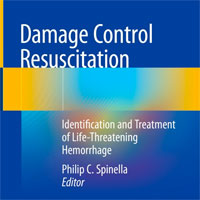Tag: hypotension
Push-Dose Epinephrine Use in the Emergency Department
A retrospective multi-site cohort study investigated the use of push-dose epinephrine (PDE) in emergency departments (EDs) for managing hypotension in critically ill patients. Recognizing the limited ED-specific data compared... read more
Hemodynamic Stabilization Using CRRT and cIVNa Combination Therapy
Compared with conventional continuous renal replacement therapy (CRRT), combination therapy of CRRT and continuous intravenous sodium infusion therapy (cIVNa) increased blood pressure, enhanced urinary volume, and reduced... read more
Early Initiated Noradrenaline vs. Fluid Therapy for Hypotension and Shock
The VASOSHOCK trial is a pragmatic, multi-center, superiority, randomized controlled trial investigating early initiation of peripheral noradrenaline in hypotension and shock, investigating the impact of this treatment on... read more
Impact of Short-Acting Beta-Blockers on the Outcomes of Septic Shock Patients
In patients with septic shock, short-acting beta-blockers may improve survival and reduce new-onset tachyarrhythmias. However, these findings were based on low certainty evidence and given ongoing concerns regarding adverse... read more
Mini Bronchoalveolar Lavage vs. Endo-Tracheal Aspirate in Diagnosing Bacterial Pneumonia in ICU
This study supports the use of endotracheal aspirate (ETA) as a cost-effective and efficient alternative to mBAL for the diagnosis of pneumonia in intubated ICU patients, particularly in settings where resources are limited.... read more
ARF Caused by Penicillium Marneffei Infection After Kidney Transplantation
Penicillium Marneffei (PM) infections often present with nonspecific clinical manifestations, and severe respiratory failure (ARF) after infection is particularly uncommon. This case report a patient who developed severe... read more
Protocolized Fluid Balance Neutralization During CRRT
Bitker et al. report the GO NEUTRAL randomized clinical trial results, which investigated fluid balance neutralization guided by functional hemodynamic monitoring (FHM) protocol versus a standard of care in critically ill... read more
The Paracetamol Challenge in ICU
Paracetamol is one of the most widely prescribed medications in critically ill patients. Our intensive care unit (ICU) administered 50.133 g of paracetamol in 2023 (16.230 intravenous [IV] doses, 33.825 oral doses and 78... read more
UFNET Fluid Removal Strategy Secured by Hemodynamic Monitoring vs. Standard of Care in patients with CRRT
An early and active UFNET strategy secured by an advanced hemodynamic protocol using dynamic indices of preload dependence had the capacity to control H72 FB in an ICU population of patients with acute circulatory failure,... read more
Fluid boluses and infusions in the early phase of resuscitation from septic shock and sepsis-induced hypotension
Fluid administration is the first line treatment in intensive care unit (ICU) patients with sepsis and septic shock. While fluid boluses administration can be titrated by predicting preload dependency, the amount of other... read more
Efficacy of β-Blockers in Decreasing Mortality in Sepsis and Septic Shock Patients
This study suggests that the use of β-blockers in sepsis and septic shock patients is associated with a significant decrease in in-hospital mortality and also associated with better patient outcomes. As β-blockers cause... read more
Risk Factors of Post-intubation Hypotension in Severe Pneumonia Patients
Post-intubation hypotension (PIH) was one of the serious complications after Endotracheal intubation (ETI) in Severe pneumonia (SP) patients. The risk factors of PIH were investigated in SP patients to provide a theoretical... read more
Hydroxocobalamin Treatment for Vasoplegia-associated Shock
Vasoplegia is generally defined as prolonged vasodilation due to a pathological decrease in systemic vascular resistance, which causes persistent hypotension even in the setting of normal or increased cardiac output. Vasoplegia... read more
Damage Control Resuscitation: Identification and Treatment of Life-Threatening Hemorrhage
This book provides a comprehensive overview of damage control resuscitation (DCR), an evidence-based approach to the resuscitation of patients with severe life-threatening hemorrhage (LTH). It focuses on both civilian... read more

A Global Perspective on AKI After Major Surgery
Acute kidney injury (AKI) is an abrupt decline in kidney function occurring within hours or days. In patients having surgery, postoperative AKI is a major complication associated with adverse outcomes including mortality.... read more
Tracheal Intubation of Critically Ill Adults: Video vs. Direct Laryngoscopy
Successful intubation on the first attempt occurred in 600 out of 705 patients (85.1%) in the video-laryngoscope group and 504 out of 712 (70.8%) in the direct-laryngoscope group (ARR, 14.3%; 95% CI, 9.9 to 18.7; p... read more
Early Control of Elevated Blood Pressure – INTERACT3
Early control of elevated blood pressure is the most promising treatment for acute intracerebral hemorrhage. We aimed to establish whether implementing a goal-directed care bundle incorporating protocols for early intensive... read more
Ground-breaking New AI Technology for Severe Sepsis Rapid Identification
ASEP Medical Holdings Inc. announced the ground-breaking use of artificial intelligence (AI) to rapidly identify infections at increased risk of severe sepsis. The method was developed by the Hancock Lab, under the guidance... read more
Fluid Therapy for Critically Ill Adults with Sepsis
Fluids are an important component of treating patients who are critically ill with sepsis. Although optimal fluid management in patients with sepsis remains uncertain, clinicians should consider the risks and benefits of... read more
Prostacyclin Anticoagulation Efficacy in Critically Ill Patients Requiring Extracorporeal Support
Extracorporeal support modalities are highly prothrombotic. Anticoagulation is frequently used for patients receiving Continuous Renal Replacement Therapy (CRRT), Molecular Adsorbent Recirculating System (MARS), and Extracorporeal... read more
Immediate Norepinephrine vs. Initial Fluid Loading
In endotoxemic shock, immediate start of norepinephrine significantly improved regional splanchnic and intestinal microcirculatory flows when compared with mandatory fixed-dose fluid loading preceding norepinephrine. Immediate... read more
Prehospital IV Fluid Management in Severely Injured Trauma Patients
Weak, primarily observational evidence suggests that standard fluid resuscitation has no significant mortality benefit over restricting/withholding IV fluids in the context of severe/hypotensive trauma. This review adds... read more









